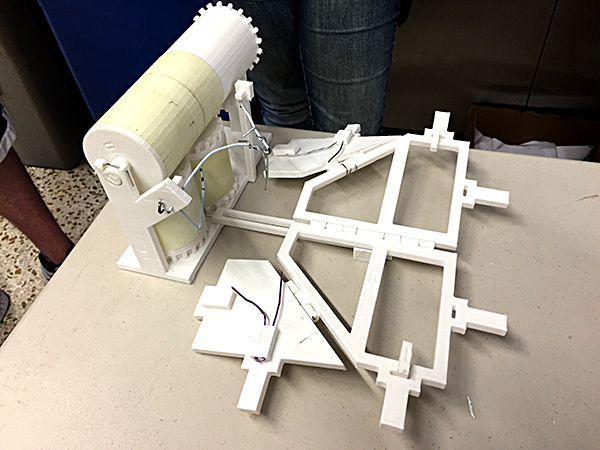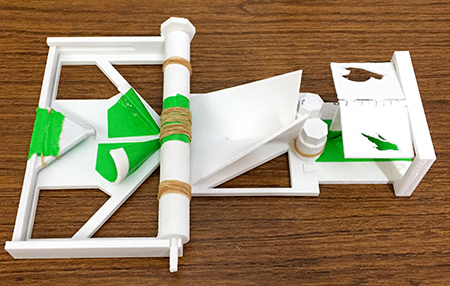As part of her Spring 2016 course on constraint-based modeling, Rosemary Astheimer challenged her students to design a device to manufacture a paper airplane.
 Astheimer, continuing lecturer in computer graphics technology, teaches CGT22600 (Introduction to Constraint-Based Modeling), and her students accepted the challenge as part of a competition sponsored by Partners for the Advancement of Collaborative Engineering Education (PACE).
Astheimer, continuing lecturer in computer graphics technology, teaches CGT22600 (Introduction to Constraint-Based Modeling), and her students accepted the challenge as part of a competition sponsored by Partners for the Advancement of Collaborative Engineering Education (PACE).
“This is the second semester I’ve had my students participate in the PACE competition, which helps to enforce the Purdue Polytechnic’s initiative to produce graduates with deep knowledge and experiences as well as problem solving, critical thinking, communication and leadership skills,” Astheimer said.
By focusing their learning on this project, Astheimer was able to provide real-world experiences that tested their problem-solving skills and offered insights into current technology challenges.
Twelve teams (60 students total) were charged with designing a device, made of several parts, that could form a letter-sized sheet of paper into a projectile to be launched. The parts were to be created using 3D printers in the college’s BoilerMaker Lab.
Through the project, the students learned valuable lessons about the manufacturing process, including:
- It is important to understand the constraints of the manufacturing process, in this case the 3D printers. Some of the submitted designs, while within the size requirements, would have taken days to complete. Designs had to be modified to reduce the printing time and amount of material.
- Testing for precision is important. In manufacturing, designs often allow for slight variances in size or weight, known as tolerances. A 3D printer, however, can create larger tolerances than anticipated. Smaller features were not produced exactly.
- Material used by 3D printers to support structures as they are being built is difficult to remove, making the final product slightly different from the design. (See examples of support material.)
 For their final presentation, the students presented their designs and test findings to Astheimer, teaching assistant Shawn Ruemler, and employees of the General Motors Vehicle Tech Center in Warren, Michigan, and Siemens PLM Software:
For their final presentation, the students presented their designs and test findings to Astheimer, teaching assistant Shawn Ruemler, and employees of the General Motors Vehicle Tech Center in Warren, Michigan, and Siemens PLM Software:
- Elizabeth Nunning, Global PT VSE – Global RWD Luxury Cars (GM)
- Richard E. Smith, Senior DRE – Suspension & Structures (GM)
- Nancy Neikrk, project manager, GM Knowledge Center
- Sam Kuan, Sr. NX Marketing Manager of NX Product Engineering Software (Siemens)
Teams were evaluated on form, fit and function of their designs, presentation, and teamwork. All participants were presented with a certificate of participation and the top three teams received prizes provided by PACE and Siemens.
